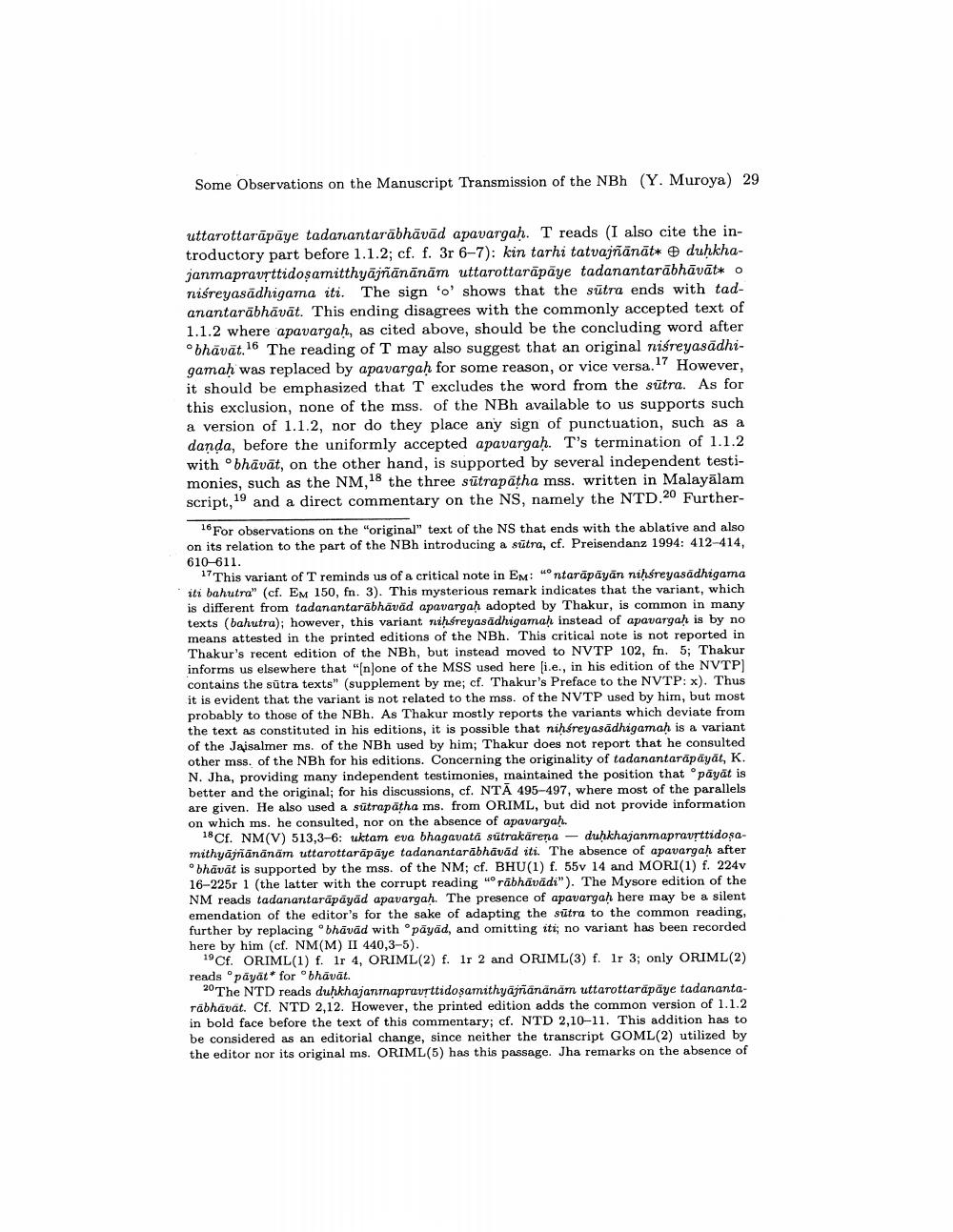Book Title: Some Observations On Manuscript Transmission Of Nyayabhasya Author(s): Yasutaka Muroya Publisher: Yasutaka Muroya View full book textPage 7
________________ Some Observations on the Manuscript Transmission of the NBh (Y. Muroya) 29 uttarottarāpāye tadanantarabhāvād apavargah. T reads (I also cite the introductory part before 1.1.2; cf. f. 3r 6–7): kin tarhi tatvajñānāt* duhkhajanmapravsttidosamitthyājñānānām uttarottaräpäye tadanantarābhāvāt* o niśreyasādhigama iti. The sign o' shows that the sūtra ends with tadanantarābhāvāt. This ending disagrees with the commonly accepted text of 1.1.2 where apavargah, as cited above, should be the concluding word after bhāvāt. 16 The reading of T may also suggest that an original nisreyasädhigamah was replaced by apavargaḥ for some reason, or vice versa.17 However, it should be emphasized that T excludes the word from the sutra. As for this exclusion, none of the mss. of the NBh available to us supports such a version of 1.1.2, nor do they place any sign of punctuation, such as a danda, before the uniformly accepted apavargah. T's termination of 1.1.2 with bhāvāt, on the other hand, is supported by several independent testimonies, such as the NM, 18 the three sūtrapātha mss. written in Malayālam script,19 and a direct commentary on the NS, namely the NTD 20 Further 16 For observations on the "original" text of the NS that ends with the ablative and also on its relation to the part of the NBh introducing a sutra, cf. Preisendanz 1994: 412-414, 610-611. 17 This variant of T reminds us of a critical note in EM: "ontarāpāyān nihsreyasādhigama iti bahutra" (cf. EM 150, fn. 3). This mysterious remark indicates that the variant, which is different from tadanantarābhavad apavargah adopted by Thakur, is common in many texts (bahutra); however, this variant Tihśreyasādhigamah instead of apavargah is by no means attested in the printed editions of the NBh. This critical note is not reported in Thakur's recent edition of the NBh, but instead moved to NVTP 102, fn. 5; Thakur informs us elsewhere that "none of the MSS used here (i.e., in his edition of the NVTP) contains the sūtra texts" (supplement by me; cf. Thakur's Preface to the NVTP:x). Thus it is evident that the variant is not related to the mss. of the NVTP used by him, but most probably to those of the NBh. As Thakur mostly reports the variants which deviate from the text as constituted in his editions, it is possible that nihfreyasādhigamah is a variant of the Jaisalmer ms. of the NBh used by him; Thakur does not report that he consulted other mss. of the NBh for his editions. Concerning the originality of tadanantaräpäyát, K. N. Jha, providing many independent testimonies, maintained the position that pāyāt is better and the original; for his discussions, cf. NTĀ 495-497, where most of the parallels are given. He also used a sutrapatha ms. from ORIML, but did not provide information on which ms. he consulted, nor on the absence of apavargal 18 Cf. NM(V) 513,3-6: uktam eva bhagavatā sutrakärena - duḥkhajanmapravrttidosamithyāmānānām uttarottarāpāye tadanantarābhāvād iti. The absence of apavargah after bhāvāt is supported by the mss. of the NM; cf. BHU(1) f. 55v 14 and MORI(1) f. 224v 16-225r 1 (the latter with the corrupt reading "rābhāvädi"). The Mysore edition of the NM reads tadanantarāpāyād apavargah. The presence of apavargah here may be a silent emendation of the editor's for the sake of adapting the sutra to the common reading, further by replacing bhāvād with pāyād, and omitting iti; no variant has been recorded here by him (cf. NM(M) II 440,3-5). 19 Cf. ORIML(1) f. 1r 4, ORIML(2) f. 1r 2 and ORIML(3) f. lr 3; only ORIML(2) reads pāyāt* for bhāvāt. 20 The NTD reads duḥkhajanmapravsttidosamithyajñananam uttarottaräpäye tadanantaräbhavat. Cf. NTD 2,12. However, the printed edition adds the common version of 1.1.2 in bold face before the text of this commentary; cf. NTD 2,10-11. This addition has to be considered as an editorial change, since neither the transcript GOML(2) utilized by the editor nor its original ms. ORIML(5) has this passage. Jha remarks on the absence ofPage Navigation
1 ... 5 6 7 8 9 10 11 12 13 14 15 16 17 18 19 20 21 22 23 24 25 26 27 28 29 30 31 32 33 34 35 36 37 38 39 40 41 42
